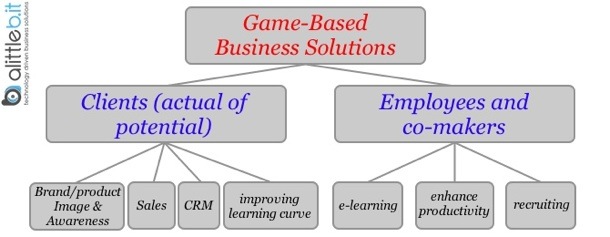The recipients and objectives of game-based business solutions

Game-based business solutions can take advantage of the paradigms of gamification and use the instruments of the game-based marketing (see our previous post). But which are the recipients and the objectives of these kinds of solutions?
Recipients can be divided into two main different categories:
- Clients (actual of potential): they are the whole market demand and they include both the actual clients and the ones that can be reached by the diffusion of the service or product, encouraged by the spreading of viral or traditional communication campaigns.
- Employees and co-makers: they represent a very specific group and the solution is often tailored to fulfill a particular need, related to the enhancement of the productivity, the communication of the corporate culture or the testing of working skills in a simulated environment.
The objectives are directly correlated to the target audience. If the recipients of game-based business solution are clients, we can improve:
- brand/product image and awareness
- sales
- CRM strategies
- learning curve of the service or product
For example, the enhancement of the image of a brand can be achieved investing in a product placement campaign or in an advergame or adverworld that can involve the audience and expose them to the communication message.
Game-based solutions are also powerful means to boost the sales of a product and many strategies can be performed to achieve such objective: it’s possible to relate the product to a gamified online platform, providing codes on the packages that unlock virtual goods or other benefits. Numerous researches have been demonstrated that a well-planned in-game advertising can increase the expenditure of the users and a better return of investment – e.g. Electronic Arts Inc. revealed results from a study conducted by The Nielsen Company which shows the degree to which brand advertisements within video games can boost real life sales. The study, commissioned by EA on behalf of Gatorade, shows that in-game advertising increased household dollars spent on Gatorade by 24%, and offered a return on investment of $3.11.
The company interaction with customers can be improved promoting an active participation – e.g. using questionnaire to profile the users and granting a better assistance.
Finally, one of the goals of a highly integrated product placement is to let the users directly try the object or service. In this way the learning curve can be improved and the barriers of entry lowered so that the potential success of the product or service is maximized.
For employees and co-makers game-based marketing and gamification objectives are different and represented by various typical corporate matters: e-learning, productivity and recruiting.
The process of learning can be simplified using game mechanics: they allow to decrease the relating underlying fatigue and the progress of the users can be easily monitored because of the learning steps are related to the advances into the gamified system.
Productivity is one main struggle in a corporate environment. Employees can be stimulated to maximize productivity, introducing friendly competitions, objectives to reach and leaderboards that allow comparison of the performance. Moreover, thanks to gamification and game-based marketing, it’s possible to improve the existing incentive system, communicating it continuously and effectively.
Game-mechanics and game-dynamics can be used also in the recruiting process. E.g. it’s possible to test the skills of the candidates, simulating a real work environment and evaluating the effects of the choices in a wide range of situations, observing the behavior in the effort to achieve an objective.
It’s important to clearly identify the target audience and the desired objectives from the beginning of the analysis, so it will be possible to apply the best game-based marketing and communication instruments.

